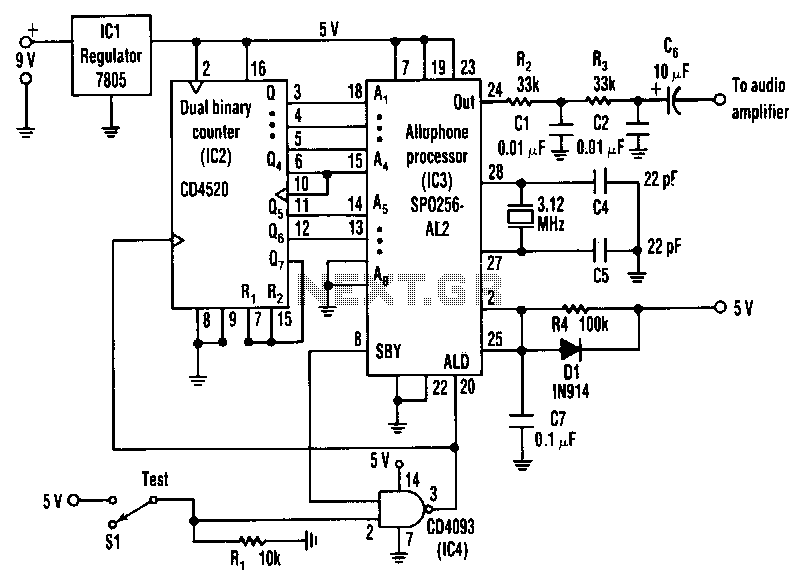
Allophone-generator

The circuit is a general-purpose system with various applications that vocalizes 59 allophones stored in the speech processor. After filtering and amplification, its pulse-code-modulated output can drive an 8-ohm speaker. The address pins of the processor, labeled A1 to A6, define 64 speech-entry points. Activating the test switch connected to the NAND gate reduces its output, which loads an address and triggers the ALD input for an allophone cycle. Additionally, the CD4520 dual binary counter, IC2, counts in binary from 0 to 63 until its Q7 output resets it at the count of 64. To generate a phrase, an EPROM can be added between IC2 and IC3, containing a program for a predetermined sequence of allophones.
The circuit operates by utilizing a speech processor capable of vocalizing a set of 59 allophones, which are the distinct units of sound in a language. The speech processor is designed to filter and amplify the generated audio signals, resulting in a pulse-code-modulated (PCM) output that is suitable for driving an 8-ohm speaker. The addressable speech-entry points are determined by the processor's address pins, A1 through A6, allowing for a total of 64 unique entries.
The inclusion of a test switch connected to a NAND gate serves a crucial function in the operation of the circuit. When the test switch is engaged, it lowers the output of the NAND gate, which in turn loads a specific address into the processor. This action triggers the ALD input, initiating a cycle to vocalize the selected allophone.
The CD4520 dual binary counter, designated as IC2 in the schematic, plays a vital role in counting the binary values from 0 to 63. The counter's Q7 output is designed to reset the counter upon reaching the count of 64, ensuring that the counting process remains within the defined range. This binary counting is essential for addressing the speech processor accurately.
For applications requiring the generation of phrases, an EPROM can be strategically placed between the output of IC2 and the input of IC3. This EPROM is programmed with a specific sequence of allophones, allowing for the playback of predetermined phrases when the circuit is activated. This feature enhances the versatility of the circuit, making it suitable for various speech synthesis applications. Overall, the design integrates digital counting, audio processing, and programmable logic to create a functional speech synthesis system.The circuit, a general-purpose system with many uses, vocalizes 59 allophones contained in the speech processor. After filtering and amplification, its pulse-code-modulated output can drive an 8-!l speaker. The processor"s address pins, Al to A6, define 64 speech-entry points. Closing the test switch to the NAND gate lowers its output, thereby loading an address and triggering the ALD input for an allophone cycle.
The CD4520 dual binary counter, IC2, counts from 0 to 63 in binary code until its Q7 output resets it on the number 64 count. To generate a phrase, just add an EPROM between IC2 and IC3 that contains a program for a predetermined sequence of allophones.
The circuit operates by utilizing a speech processor capable of vocalizing a set of 59 allophones, which are the distinct units of sound in a language. The speech processor is designed to filter and amplify the generated audio signals, resulting in a pulse-code-modulated (PCM) output that is suitable for driving an 8-ohm speaker. The addressable speech-entry points are determined by the processor's address pins, A1 through A6, allowing for a total of 64 unique entries.
The inclusion of a test switch connected to a NAND gate serves a crucial function in the operation of the circuit. When the test switch is engaged, it lowers the output of the NAND gate, which in turn loads a specific address into the processor. This action triggers the ALD input, initiating a cycle to vocalize the selected allophone.
The CD4520 dual binary counter, designated as IC2 in the schematic, plays a vital role in counting the binary values from 0 to 63. The counter's Q7 output is designed to reset the counter upon reaching the count of 64, ensuring that the counting process remains within the defined range. This binary counting is essential for addressing the speech processor accurately.
For applications requiring the generation of phrases, an EPROM can be strategically placed between the output of IC2 and the input of IC3. This EPROM is programmed with a specific sequence of allophones, allowing for the playback of predetermined phrases when the circuit is activated. This feature enhances the versatility of the circuit, making it suitable for various speech synthesis applications. Overall, the design integrates digital counting, audio processing, and programmable logic to create a functional speech synthesis system.The circuit, a general-purpose system with many uses, vocalizes 59 allophones contained in the speech processor. After filtering and amplification, its pulse-code-modulated output can drive an 8-!l speaker. The processor"s address pins, Al to A6, define 64 speech-entry points. Closing the test switch to the NAND gate lowers its output, thereby loading an address and triggering the ALD input for an allophone cycle.
The CD4520 dual binary counter, IC2, counts from 0 to 63 in binary code until its Q7 output resets it on the number 64 count. To generate a phrase, just add an EPROM between IC2 and IC3 that contains a program for a predetermined sequence of allophones.